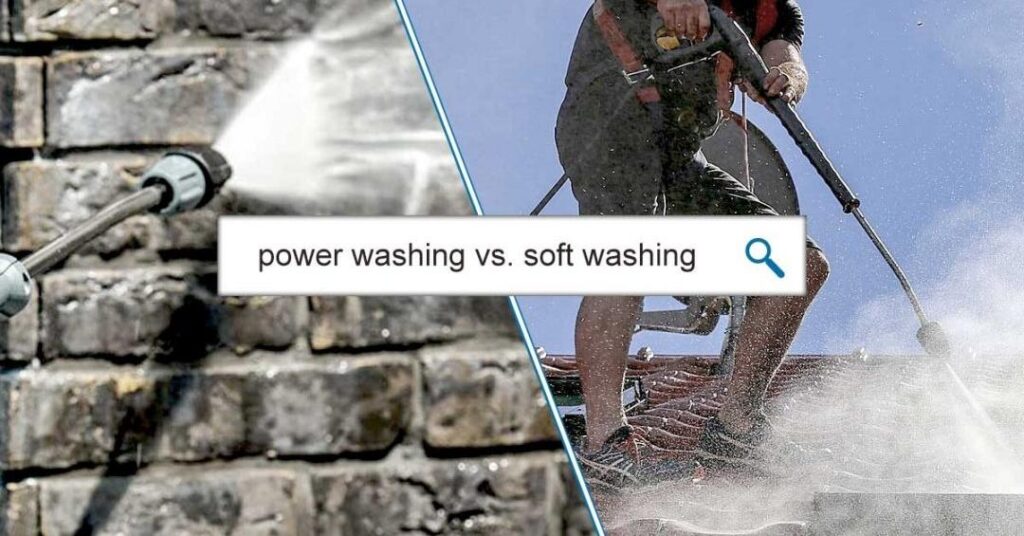When restoring the appearance of your home’s exterior, two cleaning methods often come into play: power washing and soft washing. Both techniques have their merits, but understanding their differences is critical to achieving the best results for your cleaning project. In this guide, we’ll delve into the distinctions between power washing and soft washing, helping you choose the appropriate method based on your needs.
Understanding Power Washing: Harnessing High-Pressure Precision
Power washing is a cleaning method that employs high-pressure water to dislodge dirt, grime, and stains from surfaces. This forceful approach efficiently cleans durable materials like concrete, brick, and hard surfaces. The sheer cleaning power of power washing is invaluable for removing stubborn stains and heavy dirt buildup.
Exploring Soft Washing: The Gentle Touch
In contrast, soft washing is a gentler method that utilizes low-pressure water and specialized cleaning solutions to clean surfaces. This approach is ideal for delicate and fragile materials like roofs, siding, and surfaces with potential vulnerabilities. Soft washing is particularly effective for treating organic growth such as algae, mold, and mildew.
Critical Differences Between Power Washing and Soft Washing
Pressure Levels: The primary difference lies in the pressure levels used. Power washing employs high-pressure water jets suitable for solid and sturdy surfaces. In contrast, soft washing relies on low-pressure streams less likely to cause damage.
Suitable Surfaces: Power washing is best suited for surfaces that can withstand higher pressure, such as concrete driveways and sidewalks. On the other hand, soft washing is designed for more fragile materials like roofing shingles and siding, where high-pressure water could lead to structural damage.
Cleaning Approach: Power washing focuses on forcefully removing grime and stains, making it perfect for heavy-duty cleaning. Soft washing, however, prioritizes gentle treatment to address stains at their source, making it more effective for organic growth and preserving delicate materials.
When to Choose Power Washing
Power washing is the method of choice when dealing with tough stains, grease, oil, and heavy dirt buildup. It’s particularly effective in industrial and commercial settings where concrete and hard surfaces require deep cleaning. Power washing’s high-pressure application can swiftly and effectively clean expansive spaces if you’re looking for rapid cleaning of large areas.
When to Choose Soft Washing
Soft washing shines when dealing with surfaces that require a more delicate touch. This method is ideal for cleaning fragile materials such as roofing structures and siding. Additionally, if your exterior has fallen victim to organic growth like algae, mold, or mildew, soft washing’s ability to treat these issues at its source is preferable.
Benefits of Power Washing
Power washing’s forceful approach offers several advantages:
- Effective removal of stubborn stains and grime
- Suitable for heavy-duty cleaning in commercial and industrial spaces
- Rapid cleaning of large areas due to high-pressure application
Benefits of Soft Washing
Soft washing’s gentle method comes with its own set of advantages:
- Gentle cleaning that prevents surface damage
- Effective treatment of underlying issues like mold and mildew
- Safe for delicate materials and roofing structures
Safety Considerations and Environmental Impact
Both power washing and soft washing require safety precautions. While power washing’s high pressure can potentially damage delicate surfaces, soft washing’s use of low-pressure water reduces this risk. It’s essential to wear appropriate protective gear and maintain safe distances regardless of your chosen method.
Regarding environmental impact, power washing can consume more water and potentially cause runoff that may harm the environment. Soft washing, on the other hand, often utilizes eco-friendly detergents and strongly emphasizes minimizing environmental contamination.
DIY vs. Professional Services
While power washing can often be tackled as a DIY project for surfaces like concrete, soft washing is more complex due to the specialized cleaning solutions and techniques involved. Hiring professionals for both methods ensures optimal results, especially for delicate surfaces and hard-to-reach areas.
Conclusion: Making the Informed Choice
In the power washing vs. soft washing debate, the correct method depends on the nature of your cleaning project. By understanding the key differences between these techniques, you can make an informed decision that leads to outstanding cleaning results. Whether you’re dealing with tough stains or organic growth, there’s a suitable solution that will leave your surfaces looking renewed and refreshed.
Special thanks to Spotless Abode Exterior Cleaning Services






